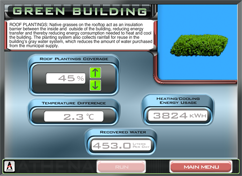Green Building

Are a bucket of green paint and a brush the only things required to make a green building? Not likely when it comes to creating a truly "green" structure. Engineering a building to be green involves designing and implementing features that reduce the amount of natural resources needed to construct and to maintain the building. Are you ready to go green?
What is active solar energy?
Active solar energy relies on the direct conversion of sunlight into either electrical or heat energy. A photovoltaic solar cell captures sunlight and transforms the light energy into electrical energy that can be used to power electrical devices. A water-filled solar panel converts sunlight into heat that is used to raise the temperature of the water. The hot water can then be used for direct consumption, such as the hot water tap in a restroom, or to heat interior space through a radiant heating system.What is passive solar energy?
Passive solar energy relies on using sunlight and the energy from the sun to immediately provide light or heat. An example of solar lighting would be large exposed windows that allow unfiltered light to illuminate a room. Window shades could be opened or closed to provide appropriate indoor lighting levels. Facing windows towards the south in northern latitudes with the window's shades open would provide radiant heating to the inside of a building during the cold winter months on days that the sun was not obscured by clouds.What is a cistern?
A cistern is a large water collection and storage tank that captures natural rainfall and recycles it for use in a building. Since the water is not treated in any manner prior to its use, the water from a basic cistern system should not be used for human consumption. However, the water could be used for "gray" uses, such as the water in toilets and for outdoor landscaping irrigation.What is a low VOC material?
VOC stands for volatile organic compounds. These are compounds that release possibly dangerous fumes into the air. A number of ordinary household products such as furniture and bedding typically contain and outgas VOC. This emission can seriously negatively affect the quality of indoor air. A number of respiratory and immune system disorders have been linked to poor indoor air quality due to high concentrations of VOC. Low VOC materials release much smaller amounts of VOC in air.Walkthrough
Tier 2 Lessons: Grades 7 - 12+
You need to log in to access this simulation.



